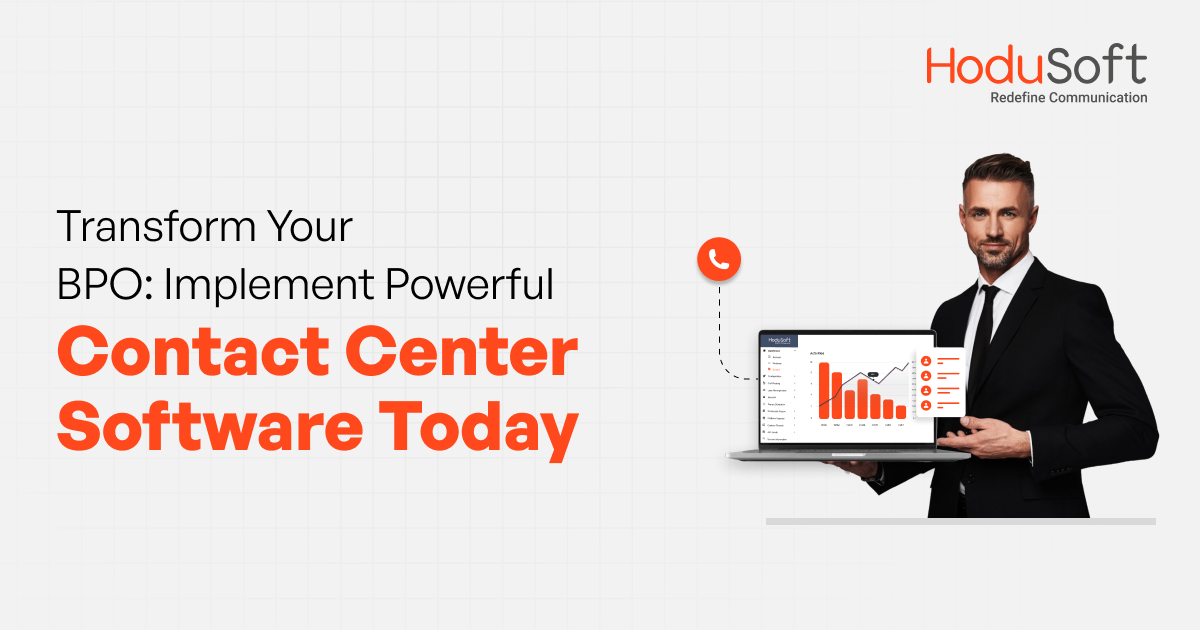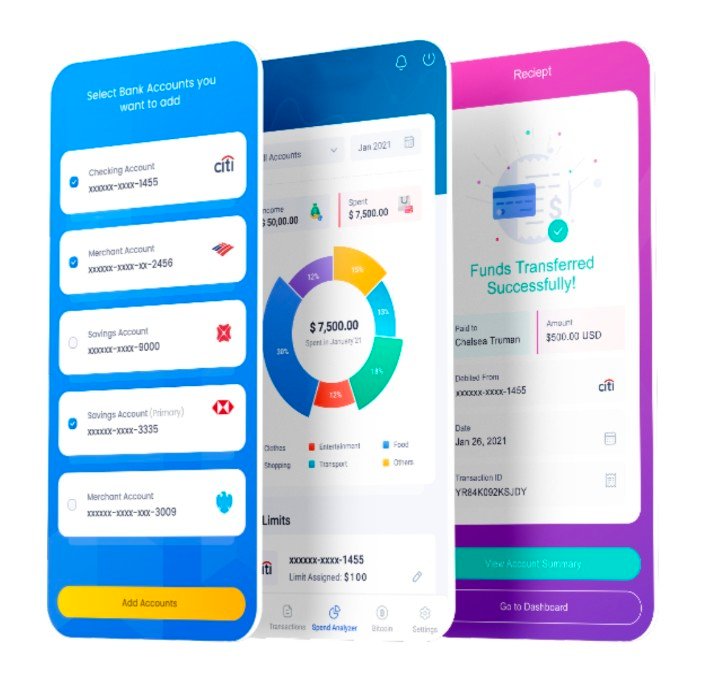business
Transform Your BPO: Implement Powerful Contact Center Software Today
Transform Your BPO: Implement Powerful Contact Center Software Today

“Change is inevitable, but transformation is a choice.” The quote by celebrated author Heather Ash Amara is so apt in the rapidly changing digital era. Businesses in all sectors, including BPOs, are doing whatever it takes to transform their operations starting from manufacturing and providing services and customer service.
Gone are the days when BPO contact centers used to provide customer service using traditional telephone systems. In the age of generative Artificial Intelligence (AI) and Machine Learning (ML), businesses in the BPO industry must keep pace with the new developments in the technology sector.
That’s where choosing the right communication solution and software can make all the difference between success and failure. If you are looking to transform your BPO, then it’s prudent to handpick the right contact center software. In this blog post, we discuss the power of the right contact center software that it can infuse into your BPO contact center. Read on and thank us later.
The Power of Sophisticated Contact Center Software
Sophisticated contact center software can make a lot of difference to BPO contact centers as it brings a lot of benefits to contact centers.
1. Omnichannel Capabilities
In today’s time, a majority of customers would rather connect with businesses by using a wide range of communication channels instead of traditional phone calls. A study revealed that about 72 percent of customers say they prefer to connect with businesses by using a wide range of communication channels. However, one new data published in VCC Live provided some shocking insights. As per the stat, less than 50 percent of contact centers can provide the desired omnichannel experience to their customers.
That’s where sophisticated contact center software can come to the rescue of BPOs. They not only can empower BPOs to provide superior customer experience but also deliver a consistent and unified experience to customers. Apart from that, advanced BPO contact center software can enable agents to handle multiple customer interactions at any given point in time as opposed to focusing on one call at a time as they used to do in the traditional call centers.
2. Real-time Analytics
Real-time analytics in BPOs are just like medical monitors in hospitals. They not only show real-time call updates but also show the overall health of a BPO contact center. When contact centers collect relevant analytics, they not only analyze key performance indicators but can personalize customer interactions.
As per one recent research conducted by Zendesk, nine out of every ten customers said that they’ll buy more from brands that provide them with personalized customer services. But when it comes to actual delivery of personalized customer communication, 85 percent of businesses feel they provide personalized customer service, while just found only 60 percent of customers feel that, reveals a study by Segment.
3. Integration with Business Application and CRM System
With BPOs and contact centers using Customer Relationship Management (CRM) systems and varied business applications such as ticketing systems more than ever before, their integration with the communication system is extremely critical for seamless customer service. That’s where sophisticated contact center software can be extremely useful.
Advanced and cutting-edge contact center software not only integrates a wide range of business applications but they enable customer service representatives to track every previous customer interaction, transaction history, and several other relevant details.
4. Automation and AI Features
Automation and Artificial Intelligence (AI) are extremely important for BPOs. As per one recent study, AI-powered chatbots and virtual assistants can enhance customer satisfaction by 20 percent. But unfortunately, very few BPO contact centers are leveraging automation and AI to enhance their operations. As per new research, over 50 percent of BPOs that took part in the study plan to use AI, and nearly a third of them plan to use robotics and process automation to automate repetitive and mundane tasks and queries.
The right contact center software can make that dream into reality. Sophisticated contact center software comes equipped with the right automation and AI tools such as chatbots, virtual assistants, intelligent routing, and automated workflows that can automate several aspects of customer service.
5. Enhanced FCR
Did you know that as many as 86 percent of customers want their call to be resolved on the very first instance when they call a business’s customer care number? A study by SQM Group revealed the stat. Another study found that when a follow-up call is needed to resolve the issue, the customer satisfaction rate drops by 15 percent. Also, nearly 90 percent of customers don’t want to repeat their issues to multiple agents.
As per industry standards, an FCR of 80 percent or more is desirable. However, a business should aim for higher FCR as that would mean that a majority of its customers are happy with the customer service. When BPO contact centers invest in the right contact center software, they can maintain high FCR, and that results in high customer satisfaction.
Things to Consider While Implementing Sophisticated Contact Center Software
Implementing powerful contact center software is a transformative process that requires careful planning and execution. Here are some key steps to consider:
1. Assess Your Current Processes
Noted writer Rajen Jani rightly said, “Assessment precedes improvement.” If you want to improve your BPO contact center’s operations, you need to assess your existing contact center processes at the outset and then make necessary changes. To conduct a thorough assessment, start with identifying pain points, bottlenecks, and areas for improvement.
This analysis will help you determine the most important features your contact center software needs to have. It will also enable you to set a reasonable budget so that you can buy the right contact center solution without over-investing or under-investing.
2. Handpick the Right Software Provider
To make the most out of your BPO contact center, invest in the right technology. It’s one thing to determine the features of contact center software and set a reasonable budget. But it’s a different ball game altogether to find the right software provider in such a competitive marketplace.
When looking for a reputable and reliable software provider type high-intent search terms such as “best contact center provider in (your city/country),” “top contact center solution provider in (your city/country),” “most cost-effective call center solution provider,” and more.
3. Customize and Integrate
“First you harmonize, then you customize.” These words of American musician and lyricist Wilson Pickett highlight the importance of customization. To run your BPO contact center as smoothly as possible, you need to make sure that your contact center software and communication systems work well with your existing systems.
After getting the contact center software, customize and integrate it to suit your BPO’s unique needs. When it comes to the integration with existing business applications and systems, such as the Customer Relationship Management system, ensure the software is versatile enough and is compatible with a wide range of business applications.
4. Continuous Training and Monitoring
The transition to new software requires proper training for agents and staff. Implement a robust change management plan to ensure a smooth adoption process and minimize disruptions to ongoing operations.
After implementation, monitor the performance of the contact center software continuously. Gather feedback from agents and customers, and make necessary adjustments to optimize efficiency and customer satisfaction.
Taking Everything into Consideration,
In the rapidly changing digital landscape, BPOs shouldn’t regard investing in sophisticated contact center software as a choice but a necessity. The right contact center software not only can transform BPO contact centers but also drive operational efficiency and revolutionize customer interactions. If you own a BPO contact center, you should make sure that you handpick the right contact center software provider and leverage sophisticated contact center solutions.
business
How to Use Share Market Apps to Track the Sensex Index Effectively
Sensex Index today, short for the S&P BSE Sensex, is one of the most prominent stock market indices in India

Sensex Index today, short for the S&P BSE Sensex, is one of the most prominent stock market indices in India. It represents the performance of 30 financially sound and established companies listed on the Bombay Stock Exchange (BSE). For investors and traders, tracking the Sensex is crucial to understanding the overall market sentiment and making informed investment decisions. With the advent of share market apps, tracking the Sensex has become more accessible, convenient, and efficient. Here’s a comprehensive guide on how to use share market apps effectively to track the Sensex index.
1. Choose the Right Share Market App
The first step in effectively tracking the Sensex is to select a reliable and feature-rich share market app. Numerous apps cater to different types of investors, from beginners to seasoned traders. When choosing an app, consider factors such as:
- User Interface (UI) and User Experience (UX): A clean and intuitive interface makes it easier to navigate through the app and find relevant information quickly.
- Real-Time Data: Ensure the app provides real-time updates on the Sensex and other market indices.
- Analytical Tools: Look for apps that offer charting tools, technical indicators, and market analysis.
- News and Notifications: An app that provides the latest news, alerts, and notifications about market movements is crucial for staying informed.
2. Set Up a Personalized Dashboard
Once you’ve chosen an app, the next step is to set up a personalized dashboard. A dashboard is the first screen you see when you open the app, and it should display all the essential information at a glance. Here’s how you can customize it for effective Sensex tracking:
- Add Sensex to Favorites: Ensure that the Sensex index is added to your list of favorite or watchlist indices. This allows you to view its performance directly from the dashboard.
- Monitor Key Stocks: Since the Sensex is composed of 30 major companies, it’s beneficial to track the performance of these individual stocks as well. Add them to your watchlist to monitor their price movements.
- Set Up Alerts: Most share market apps allow you to set up alerts for specific price levels, percentage changes, or volume spikes. Set alerts for the Sensex to get notified when it reaches certain milestones or experiences significant fluctuations.
3. Utilize Analytical Tools
Effective tracking of the Sensex isn’t just about watching the numbers; it’s about understanding the trends and making predictions based on them. Here’s how to leverage the analytical tools available in the share market app:
- Technical Analysis: Use charting tools to analyze the Sensex’s historical performance. Look for patterns such as support and resistance levels, moving averages, and trend lines. Technical indicators like the Relative Strength Index (RSI), Moving Average Convergence Divergence (MACD), and Bollinger Bands can also provide insights into the market’s momentum.
- Sentiment Analysis: Some apps offer sentiment analysis tools that gauge market sentiment based on news, social media mentions, and trading volumes. This can help you understand the broader market mood and its potential impact on the Sensex.
- Fundamental Analysis: While tracking the Sensex, it’s also essential to consider the fundamentals of the companies that make up the index. Review quarterly earnings reports, financial ratios, and management commentary to get a sense of how these companies are performing and their potential impact on the index.
4. Stay Informed with Market News
News plays a vital role in stock market movements. Political events, economic reports, global market trends, and corporate announcements can all influence the Sensex. Here’s how to stay informed:
- Real-Time News Feed: Ensure that the app you’re using offers a real-time news feed. This will keep you updated on the latest developments that could impact the Sensex.
- Notifications: Enable push notifications for breaking news and major market events. This way, you won’t miss out on any critical information, even when you’re not actively using the app.
- In-Depth Analysis: Some apps offer in-depth analysis and expert opinions on market movements. Reading these can provide valuable insights into the factors driving the Sensex and help you make informed decisions.
5. Use Historical Data for Backtesting
Backtesting involves testing a trading strategy on historical data to see how it would have performed in the past. Many share market apps provide access to historical data, which can be used to backtest strategies based on the Sensex’s performance. Here’s how to go about it:
- Select a Timeframe: Choose a specific timeframe for your backtesting, such as the last 1 year, 5 years, or 10 years.
- Apply Your Strategy: Apply your trading strategy to the historical data and analyze its performance. Look at key metrics such as profitability, risk, and drawdowns.
- Refine Your Strategy: Based on the results, refine your strategy to optimize its performance. Backtesting can be an effective way to develop and validate a trading approach before applying it in real-time.
6. Review Regularly and Adapt
The stock market is dynamic, and so should be your approach to tracking the Sensex. Regularly review your tracking methods, watchlists, and strategies to ensure they align with current market conditions. Be ready to adapt to changing market environments, such as economic downturns, market rallies, or geopolitical events.
business
Successfully Sell Hand-Me-Down Cars Online Laguna Niguel CA
Selling a hand-me-down car can be a rewarding experience, especially when you tap into the rich history and sentimental value these vehicles often hold.

Selling a hand-me-down car can be a rewarding experience, especially when you tap into the rich history and sentimental value these vehicles often hold. In Laguna Niguel CA, the online car selling market is vibrant, making it an ideal place to find buyers who appreciate the charm of older cars. Here’s how you can make your vintage car stand out in the online marketplace.
Highlight the Vintage Appeal and Nostalgia Factor
Every hand-me-down car has a unique story that adds to its vintage appeal. In Laguna Niguel CA, buyers love a good dose of nostalgia. Emphasize the classic elements of your car that make it special. Whether it’s the timeless design, the unique features, or the simple fact that it’s a throwback to a different era, make these points shine in your listing.
The charm of vintage cars lies in their ability to transport us back in time. Mention how your car represents a piece of automotive history. Share anecdotes about its journey and how it has stood the test of time. When buyers feel that nostalgic connection, they’re more likely to see the value in your vehicle.
Create a Detailed Story of the Car’s History and Legacy
People love stories, and cars with a history can tell some of the best ones. When selling cars online in Laguna Niguel CA, detail the car’s past. Talk about its previous owners, any interesting trips it might have taken, and how it became a part of your family. This narrative not only engages potential buyers but also adds a layer of depth to the car’s character.
A car with a legacy is more than just a vehicle; it’s a piece of the past. Describe how the car has been maintained over the years, any major repairs or upgrades it has undergone, and any awards or recognitions it might have received. Buyers looking to sell my car online in Laguna Niguel CA will appreciate the added value a rich history brings.
Offer a Unique Buyer’s Guide for Restoring and Maintaining Older Cars
Older cars require special care and attention, and potential buyers may be unsure of how to handle them. Provide a comprehensive guide on how to restore and maintain your car. Include tips on sourcing parts, recommended mechanics in Laguna Niguel CA, and advice on regular upkeep. This added value can make your listing more attractive and helpful.
Restoration can be a daunting task, but with the right guidance, it becomes an exciting project. Break down the process into manageable steps and highlight any resources or support available locally. When you sell your car online in Laguna Niguel CA, offering this guide shows buyers that you’re knowledgeable and supportive, increasing their confidence in the purchase.
Use High-Quality, Stylized Photos to Capture the Car’s Character
A picture is worth a thousand words, and high-quality photos can make all the difference in online car selling in Laguna Niguel CA. Capture your car’s character with stylized, professional photos. Highlight its best features, unique angles, and any details that showcase its vintage appeal.
Lighting and setting play a crucial role in photography. Choose a location that complements the car’s style, whether it’s a scenic backdrop or a retro setting. High-resolution images that highlight the car’s condition and charm can captivate potential buyers, making them more likely to reach out.
Emphasize the Sentimental Value in Your Listings
Sentimental value can turn a simple transaction into an emotional investment. Share why the car is special to you and your family. Explain the memories associated with it and why you’ve cared for it so diligently. This personal touch can resonate with buyers looking to sell my car online in Laguna Niguel CA, creating a deeper connection.
Buyers appreciate honesty and authenticity. Be genuine about the sentimental value the car holds, and explain why you hope it goes to a good home. When potential buyers see the care and affection you have for the car, they’re more likely to value it beyond just its physical attributes.
Successfully selling hand-me-down cars online in Laguna Niguel CA requires more than just listing the basic details. By highlighting its vintage appeal, sharing its history, providing maintenance guides, using high-quality photos, and emphasizing sentimental value, you can create a compelling and engaging listing that attracts the right buyers. Embrace the charm and story of your car, and watch as it captivates a new owner who will cherish it just as much as you have.
business
Revolutionizing Business Operations with Enterprise Application Development Platforms
Revolutionizing Business Operations with Enterprise Application Development Platforms In today’s competitive business landscape, the ability to efficiently manage operations, streamline processes

Introduction
In today’s competitive business landscape, the ability to efficiently manage operations, streamline processes, and deliver exceptional customer experiences is paramount. To achieve this, organizations rely on sophisticated software systems known as enterprise applications. The development and management of these applications are critical to a company’s success. This is where an enterprise application development platform comes into play—a solution designed to simplify the development, deployment, and maintenance of enterprise-grade applications.
Understanding Enterprise Application Development Platforms
An enterprise application development platform is a comprehensive software environment that provides the tools and infrastructure necessary to develop, deploy, and manage large-scale business applications. These platforms are designed to handle the complexity and scale required by enterprises, enabling them to build applications that support mission-critical operations.
Unlike traditional development environments, enterprise application development platforms offer a unified approach to building applications. They integrate various development tools, frameworks, and services into a single platform, making it easier for developers to create robust applications that meet enterprise standards.
Key Features of Enterprise Application Development Platforms
Unified Development Environment: An enterprise application development platform provides a cohesive environment where developers can access all the tools they need in one place. This includes integrated development environments (IDEs), debugging tools, testing frameworks, and deployment pipelines. The unified environment simplifies the development process and reduces the learning curve for new developers.
Scalability: Enterprise applications often need to support thousands of users and handle vast amounts of data. A robust enterprise application development platform offers scalability, ensuring that applications can grow with the business and accommodate increasing demands without compromising performance.
Security: Security is a top priority for enterprise applications. These platforms come with built-in security features, such as encryption, authentication, and access control, to protect sensitive business data. Additionally, they often include compliance management tools to help organizations meet industry regulations.
Integration Capabilities: Enterprises rely on a variety of software systems to manage different aspects of their operations. An effective enterprise application development platform offers extensive integration capabilities, allowing new applications to seamlessly connect with existing systems, databases, and third-party services.
Rapid Development: The pace of business is faster than ever, and enterprises need to deliver new applications and updates quickly. These platforms often include low-code or no-code tools that enable rapid application development, allowing businesses to respond to changing market conditions swiftly.
The Importance of Enterprise Application Development Platforms
Enterprise application development platforms are essential for organizations that need to manage complex business processes efficiently. These platforms provide the infrastructure and tools necessary to build applications that support core business functions, such as finance, human resources, supply chain management, and customer relationship management.
By leveraging an enterprise application development platform, businesses can achieve several key benefits:
Increased Productivity: Developers can work more efficiently within a unified environment, reducing the time required to build and deploy applications.
Cost Savings: By streamlining the development process and reducing the need for specialized tools, organizations can lower their development costs.
Improved Collaboration: These platforms often include features that facilitate collaboration between different teams, ensuring that business requirements are accurately captured and implemented.
Faster Time to Market: The rapid development capabilities of these platforms allow businesses to launch new products and services more quickly, gaining a competitive edge.
The Role of Low-Code in Enterprise Application Development
Low-code platforms are becoming increasingly popular in the realm of enterprise application development. These platforms offer a visual approach to application development, allowing users to build applications with minimal coding. This is particularly beneficial for enterprises, as it enables faster development cycles and empowers non-developers to participate in the development process.
Legacy application modernization with low-code platforms is a key focus area within enterprise application development. By utilizing low-code’s rapid development capabilities, organizations can modernize outdated systems, improve efficiency, and enhance user experiences. Low-code platforms often integrate seamlessly with existing systems, allowing for gradual modernization without disrupting core operations.
Low-code platforms are integrated into many enterprise application development platforms, providing a way to accelerate the development of business applications. By using drag-and-drop interfaces and pre-built templates, organizations can quickly create and deploy applications that meet specific business needs. This agility enables businesses to adapt to changing market conditions and gain a competitive edge. applications that meet their specific needs.
Challenges and Considerations
While enterprise application development platforms offer numerous advantages, there are also challenges that organizations must consider:
Complexity: Implementing and managing an enterprise application development platform can be complex, especially for large organizations with diverse IT environments. Proper planning and resources are required to ensure successful adoption.
Customization: While these platforms offer extensive features, there may be limitations in terms of customization. Organizations with highly specialized needs may require additional development to tailor the platform to their requirements.
Vendor Lock-In: Relying heavily on a single platform provider can lead to vendor lock-in, making it difficult to switch platforms or integrate with other systems. Organizations should carefully evaluate platform providers and consider the long-term implications of their choice.
The Future of Low-Code Platform for Application Development
The future of low-code platform for application development is closely tied to the ongoing digital transformation of businesses. As organizations continue to embrace new technologies, these platforms will evolve to support more advanced features, such as artificial intelligence (AI), machine learning (ML), and the Internet of Things (IoT).
In addition, the trend towards more user-friendly development environments will likely continue. Low-code and no-code tools will become more sophisticated, enabling even greater participation from non-technical users in the application development process. This democratization of development will empower businesses to innovate faster and respond more effectively to changing market conditions.
Furthermore, as cloud computing becomes increasingly prevalent, low-code platform for application development will continue to shift towards cloud-native architectures. This will provide organizations with greater flexibility, scalability, and cost efficiency in managing their applications. Cloud-based platforms will also enable seamless integration with other cloud services, expanding the possibilities for application development and deployment.
Conclusion
In conclusion, enterprise application development platforms are critical tools for modern businesses. They provide the infrastructure, tools, and capabilities needed to build and manage applications that support complex business processes. By leveraging these platforms, organizations can increase productivity, reduce costs, and deliver new applications more quickly.
As the digital landscape continues to evolve, these platforms will play an increasingly important role in enabling businesses to stay competitive and meet the demands of their customers. By adopting an enterprise application development platform, organizations can position themselves for success in an ever-changing market.
-

 fashion6 months ago
fashion6 months agoEssential Clothing Brand- Raising Your Closet Basics
-

 fashion5 months ago
fashion5 months agoTips for Choosing the Right Fabric for Your Beautiful Midi Dress
-
Tech6 months ago
A Complete Checklist on Selfie Verification – How it Works in Digital Landscape
-

 business6 months ago
business6 months agoEmpowering Businesses Through Efficient HR and Payroll Outsourcing Solutions
-

 search engine optimization6 months ago
search engine optimization6 months ago2024 Best Top 10 Key SEO Tips to Boost Your Website’s Visibility
-

 travel6 months ago
travel6 months agoTravel Deeper, Spend Smarter: Unlocking Hidden Gems on a Budget
-

 technology6 months ago
technology6 months agoThe Evolution of Cybersecurity: Comprehending the Role of Hardware Firewalls in Protecting Digital Landscapes
-

 fashion5 months ago
fashion5 months agoThe Perfect Ensemble A Guide to Choosing Baby Clothes
